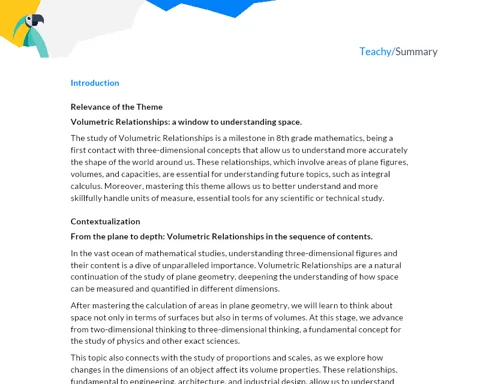Exploring Volume and Surface Area of Cylinders in Practice
Objectives
1. Calculate the volume of a cylinder using the appropriate formula.
2. Calculate the surface area of a cylinder for practical applications.
3. Relate the concepts of volume and surface area to everyday situations.
4. Develop practical and experimental skills in problem-solving.
Contextualization
Cylinders are present in various aspects of our daily lives, from simple objects like soda cans to complex structures like grain storage silos. Understanding how to calculate the volume and surface area of these objects can be essential in various professions, such as engineering, architecture, and product design. This enables professionals to make accurate measurements and optimize material usage, saving time and resources. For example, civil engineers use cylinder volume calculations to design and build water reservoirs, while packaging designers need to calculate the surface area of cylinders to determine the amount of material needed to create labels and packaging.
Relevance of the Theme
Understanding the concepts of volume and surface area of cylinders is crucial in the current context, as it allows for the resolution of practical problems and the optimization of resources in various professional fields. Professionals in engineering, architecture, and product design frequently use these calculations to ensure efficiency and precision in their projects, contributing to material savings and sustainability. Moreover, these skills are essential for developing innovative and effective solutions in an increasingly competitive and technological job market.
Cylinder Volume
The volume of a cylinder is a measure of the amount of three-dimensional space it occupies. The formula for calculating the volume of a cylinder is V = πr²h, where 'V' is the volume, 'r' is the radius of the circular base, and 'h' is the height of the cylinder.
-
The formula V = πr²h is derived from the area of the circular base (A = πr²) multiplied by the height of the cylinder.
-
Volume is expressed in cubic units, such as cubic centimeters (cm³) or cubic meters (m³).
-
Volume calculation is crucial in various applications, such as determining the capacity of cylindrical containers.
Cylinder Surface Area
The surface area of a cylinder is the measure of the total area covering its surface. The formula for calculating the surface area is A = 2πrh + 2πr², where 'A' is the area, 'r' is the radius of the circular base, and 'h' is the height of the cylinder.
-
The surface area consists of two parts: the lateral area (2πrh) and the area of the two circular bases (2πr²).
-
The surface area is expressed in square units, such as square centimeters (cm²) or square meters (m²).
-
Knowing the surface area is essential for applications such as manufacturing cylindrical labels and packaging.
Practical Applications
The concepts of volume and surface area of cylinders have numerous practical applications in various professional fields, including engineering, architecture, and product design. These applications allow for optimizing material usage and ensuring accurate measurements.
-
Civil engineers use volume calculations to design water reservoirs and storage silos.
-
Packaging designers calculate surface area to determine the amount of material needed to create labels.
-
Architects apply these concepts when designing cylindrical structures, ensuring efficiency and aesthetics.
Practical Applications
- Civil Engineering: Design cylindrical water reservoirs to optimize water storage and distribution.
- Product Design: Create efficient cylindrical packaging, minimizing material use while ensuring content protection.
- Architecture: Design cylindrical buildings and structures that combine functionality and aesthetics, such as storage silos and towers.
Key Terms
-
Volume: The amount of three-dimensional space occupied by an object, measured in cubic units.
-
Surface Area: The total measure of the area covering the surface of an object, expressed in square units.
-
Cylinder: A geometric solid with two parallel circular bases and a straight lateral surface connecting them.
Questions
-
How can calculations of the volume and surface area of cylinders impact the efficiency of material use in engineering projects?
-
In what ways can knowledge of these concepts contribute to innovation in product and packaging design?
-
What challenges did you face when applying mathematical formulas in constructing a prototype of a soda can?
Conclusion
To Reflect
Understanding and applying the concepts of volume and surface area of cylinders is fundamental for various professional areas, such as engineering, architecture, and product design. These concepts allow for accurate measurements, optimization of material usage, and efficient solutions to practical problems. When reflecting on your learning, think about how these skills can be applied in your daily life and future careers. Mathematical knowledge, when combined with practice, is a powerful tool for innovation and solving complex challenges.
Mini Challenge - Practical Challenge: Designing a Water Reservoir
Use the knowledge gained to design a cylindrical water reservoir, calculating its volume and surface area.
- Imagine that you are a civil engineer responsible for designing a water reservoir for a small community.
- Determine the dimensions of the reservoir (radius and height) based on the amount of water that needs to be stored and the space available for construction.
- Calculate the volume of the reservoir using the formula V = πr²h.
- Calculate the surface area of the reservoir using the formula A = 2πrh + 2πr².
- Draw a sketch of the reservoir, indicating the dimensions and calculations performed.
- Write a brief report explaining your choices of dimensions and how the reservoir will meet the community's needs.



